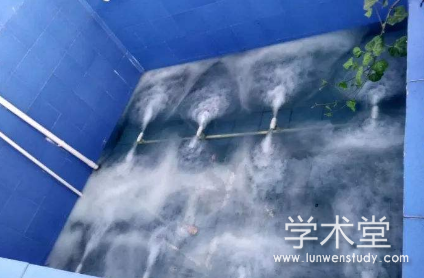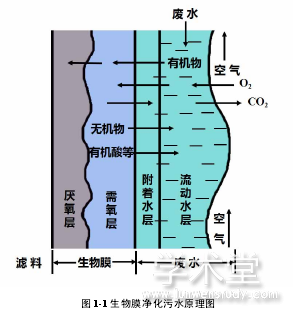摘 要
随着人们生活质量的稳步提升,生活污水的排放量也越来越大,但相当一部分都没有经过处理直接排放到环境中去。近些年来我国内陆水域的富营养化现象越来越严重,导致水华出现的频率越来越高,降低了地表水的景观性和使用性,不仅使环境承受越来越大的压力,同时也给人们的生存和健康带来了严重的威胁。BFBR(Bio-FilmBiological-Reactor 生物膜生物反应器)作为一种新兴的污水处理工艺,通过采取一定的人工技术措施(包括曝气、设置生物填料、种植挺水植物等),为微生物和挺水植物的生长创造适宜的条件,加速它们的生长和代谢,利用生物填料和挺水植物根部巨量的微生物,分解水中的有机物,并将其转化为较为简单和稳定的无机物,从而使污水变得干净。本文在 BFBR 工艺的基础上,利用课题组自行研发和设计的微纳米气泡发生器代替传统的曝气装置,旨在更好地促进挺水植物的生长,使其在污水处理过程中发挥更大的作用,使污水的处理更加彻底。
近些年来,微纳米气泡因其独特的性质而受到人们的重视,尤其是在环保行业,已经得到了较为广泛的应用。由微纳米气泡发生器产生的微米、纳米级的气泡所表现出来的理化性质与普通尺寸的气泡有很大的差别。本文通过研究对比微纳米气泡曝气状态下和普通曝气状态时水中溶解氧的影响,发现微纳米曝气状态下能将更多的氧气溶解到水中,使水中的溶解氧更容易达到饱和甚至过饱和状态,并且保持时间较长。本文还研究了微纳米气泡促进挺水植物黄菖蒲的生长,发现在黄菖蒲的生长过程中,使用微纳米气泡发生器在水中曝气要比普通的曝气生长得更快。在相同生长周期内,使用微纳米气泡曝气的黄菖蒲在株高、根长等指标上表现出明显的优势。改良型 BFBR 工艺将微纳米气泡曝气、挺水植物和生物填料集合成一个完整的系统,在处理生活污水方面显示出良好的效果。
(1)经过微纳米气泡机的曝气使水中的溶解氧浓度在很短的时间内由 0mg/L 上升到 11.3mg/L,并使水体中溶解氧的浓度达到了过饱和的状态。与此同时,普通曝气时水中的溶解氧浓度由 0mg/L 增加至 9.07mg/L,并没有使水处于溶解氧的饱和状态。原因在于微纳米气泡的直径要远远小于普通曝气的气泡直径,在水中的停留时间要比普通曝气的气泡时间长,微纳米气泡所表现出来的尺寸效应导致气相和液相之间的传质速率增高,同时微纳米气泡的表面张力会将微纳米气泡撕裂,使溶解氧饱和状态下的水体依然有很高的气液传质速率,最终导致水体中溶解氧浓度的过饱和状态出现。在停止曝气之后的三个小时内,经过微纳米气泡发生器曝气的水体中溶解氧浓度从 11.3mg/L 下降到10.8mg/L,依旧处于溶解氧浓度的过饱和状态。证明了使用微纳米曝气不仅能使更多的氧溶解到水中,还能使水中的溶解氧存在很长的时间,为后续实验的展开打下了坚实的基础。
(2)通过实验发现,在微纳米气泡曝气和普通曝气两种环境下挺水植物黄菖蒲的生长有着较大差别。实验结果表明,在微纳米气泡曝气的环境中生长 30 天的黄菖蒲的根长在 4~8cm 范围内的达到了 46 根,占比为 76.6%,大多发育良好,整体偏向成熟,而经过普通曝气的黄菖蒲的根长则主要在 1~6cm 范围内,占比为 85%,整体偏向新长出的幼根。在微纳米气泡曝气的环境中生长的黄菖蒲株高集中在 18~26cm,占黄菖蒲总数的 85%,只有 10%的黄菖蒲株高小于 18cm,相比之下,在普通曝气环境中生长的黄菖蒲的株高集中在 14~22cm,除此之外还有 15%的黄菖蒲在 14cm 以下。由此可见,在微纳米曝气环境中植株高度和根系长度方面要比普通曝气环境中生长的黄菖蒲更具优势,生长得更快、发育得更好。而挺水植物在 BFBR 工艺中承担着去除水中 N、P 等元素的重任,其生长状况的好坏,会直接影响到该工艺处理污水的效果。
(3)改良后的 BFBR 工艺在处理生活污水方面显示出很好的效果,其中 CODcr(化学需氧量)、TN(总氮)和 NH3-N(氨氮)三个指标均达到了《城镇污水处理厂污染物排放标准》中的一级 A 标准,去除率分别达到了 91.12%、82.21%和 89.10%,TP(总磷)、SS(悬浮物)两个指标也都达到了《城镇污水处理厂污染物排放标准》中的一级B 标准。相比于使用普通曝气的 BFBR 工艺,出水水质有了明显的提高,生活污水经过改良型 BFBR 工艺处理之后,可以直接排放。
关键词: BFBR 工艺,微纳米气泡,挺水植物,生活污水。
ABSTRACT
With the improvement of the quality of life, the discharge of domestic sewage is also increasing year by year, but a considerable part of it is discharged without treatment. In recent years, the eutrophication of inland waters in China has become more and more serious. As a result, the frequency of water blooms has become higher and higher, and the landscape and use of surface water have been reduced.
This not only increases the pressure on the environment. It also poses a threat to people's survival and health. As a new sewage treatment process, BFBR (Bio-Film Biological-Reactor) adopts certain artificial technical measures (including aeration, setting biological fillers, planting emergent plants, etc.) to create the growth of microorganisms and emergent plants. Appropriate conditions accelerate their growth and metabolism, utilize biological fillers and a large amount of microorganisms in the roots of emergent waterplants to decompose organic matter in the water and convert it into stable organic matter, thereby purifying sewage. Based on the BFBR process, this article replaces the traditional aeration device with a micro-nano bubble generator independently researched and designed by the research group, aiming at better promoting the growth of emergent plants and making it more effective in the process of sewage treatment. The role of sewage treatment is more thorough.
In recent years, micro-nano bubbles have received attention due to their unique properties,especially in the environmental protection industry, and have been widely used. The physicochemical properties of micro- and nano-scale air bubbles produced by micro-nanometer bubble generators are very different from those of ordinary-sized air bubbles. In this paper, we studied the effect of micro-nano bubble aeration and common aeration on dissolved oxygen in water. We found that micro-nano aeration can dissolve more oxygen into the water and make the dissolved oxygen in the water supersaturated and maintain a long time. This article also studied the micro-nano bubbles to promote the growth of theemergent water plant Iris pseudacorus L. It was found that the use of micro-nano bubbles in the growth process of Iris pseudacorus L. grows faster than ordinary aeration. In the same growth cycle, the use of micro-nano bubble aerationin the plant height, root length and other indicators showed a clear advantage.The improved BFBR process combines micro-nanometer bubble aeration, emergent water plants, and biofillers into a complete system that shows good results in the treatment of domestic sewage.
(1) After the aeration of the micro-nano bubble machine, the dissolved oxygen in the water rises from 0 mg/L to 11.3 mg/L in a short time, and the dissolved oxygen in the water reaches an oversaturated state. At the same time, the dissolved oxygen in the water during normal aeration increased from 0 mg/L to 9.07 mg/L, which did not cause the water to be in a saturated state of dissolved oxygen. The reason is that the diameter of micro-nano bubbles is much smaller than the diameter of ordinary aeration bubbles, and theresidence time in water is longer than that of ordinary aeration bubbles. The size effect of micro-nano bubbles leads to a higher gas-liquid mass transfer rate and its surface. Tension will tear the micro-nanometer bubbles, so that the dissolved oxygen saturation state of the water body still has a high rate of gas-liquid mass transfer, eventually leading to the presence of dissolved oxygen in the water supersaturated state. Within three hours after the aeration was stopped, the dissolved oxygen in the micro-nano bubble aerated water dropped from 11.3 mg/L to 10.8 mg/L, and was still in a state of supersaturated dissolved oxygen. It is proved that the use of micro-nanometer aeration can not only make more oxygen dissolved in water, but also make the dissolved oxygen in water have a long root time, laying a solid foundation for the subsequent experiments.
(2) It was found through experiments that the growth of the emergent plant Iris pseudacorus L.in the two environments of micro-nano bubble aeration and normal aeration has a great difference. The experimental results show that the root length of yellow iris growing for 30 days in the micro-nano bubble aeration environment reaches 46 roots in the range of 4~8cm, accounting for 76.6% of the total. Most of them are well developed, and the whole tends to be ripe and pass through. The root length of common aerated Iris pseudacorus L is mainly in the range of 1 to 6 cm, accounting for 85% of the total, and it is generally biased towards the newly emerged young roots. The high concentration of Iris pseudacorus L. plants growing in the micro-nano bubble aeration environment is 18 to 26 cm, accounting for 85% of the total number of yellow iris, and only 10% of the Iris pseudacorus L. plant height is less than 18 cm,compared to the normal aeration environment. The plant height of the growing yellow iris is concentrated at 14-22cm, in addition to 15% of the yellow iris below 14cm. It can be seen that the plant height and root length in the micro-nanometer aeration environment are more advantageous than the yellow acacia growing in the common aeration environment, and the growth is faster and the development is better. In the BFBR process, the emergent plants bear the heavy responsibility of removing N, P and other elements from the water. The growth status of these plants will directly affect the treatment of the sewage.
(3) The improved BFBR process shows good results in the treatment of domestic sewage, among which CODcr, TN, and NH 3 -N all meet the Class I A standard in the Urban Pollutants Discharge Standard for Pollutants. The removal rates reached 91.12%, 82.21%, and 89.10%, respectively, and the TP and SS indicators also reached the Class I B standard standard in the Urban Pollutants Discharge Standard for Pollutants. Compared with the BFBR process using ordinary aeration, the quality of effluent water has been significantly improved, and domestic sewage can be directly discharged after being treated with the modified BFBR process.
KEY WORDS: BFBR ,Micro-Nano Bubble, Domestic Sewage。
1、 绪论。
1.1、 选题背景及意义。
近些年来,随着社会经济的发展和人们生活水平的不断提高,人们对水资源的需求也越来越大,不可避免的会产生大量的生活污水。污水如果未经处理就直接排放到环境中去,水体中超标的 N、P 等营养元素不但会给水体带来严重的污染,还会引起藻类和一些浮游生物在很短的时间内迅速生长繁殖,最终会使水体恶化,出现水体富营养化现象,导致水华和赤潮的发生[1-6]。人类的生活一刻都离不开水,水华和赤潮现象将会直接危害到人们的健康,同时也给动植物的生存带来严重的威胁[7-9]。据统计,我国最大的五个淡水湖都出现了富营养化,内陆淡水湖泊的富营养化问题已经在全世界蔓延开来[10-19]。因此,生活污水治理方法的研究就显的尤为重要。
目前,生活污水的治理方法有很多,有些甚至有上百年的历史,通常情况下可以划分为两大类:物理处理法和生化处理法[20-23]。物理处理法的原理和操作都较为简单,在其工程运行过程中一般都处于最前端,是一种最常见的预处理方法。物理处理法所处理的对象一般是污水中的漂浮物以及悬浮物,主要包括筛滤节流法(格栅、筛网等)、重力节流法(沉砂池、沉淀池等)和离心分离法(旋流分离器、离心机等)[24-26]。生化处理法是利用自然界中分布广泛的微生物的适应能力强、个体微小、代谢类型多样等特点,伴随其新陈代谢过程,净化生活污水的方法[27]。生化处理法的主要原理是创造有利于微生物生长和繁殖的外部环境,增强微生物的代谢活动,从而促进微生物的繁殖,加速生活污水中部分有机物的无机化,使污水得到净化[28-30]。根据微生物新陈代谢时对水中溶解氧需求的不同,生化处理技术又可以分为好氧生物处理、缺氧生物处理和厌氧生物处理[31]。
1.2、 常用的污水处理工艺。
1.2.1、 传统活性污泥法处理系统。
上世纪初英国人 Clark 和 Gage 发现对污水进行曝气之后,会产生污泥[32],之后污水的水质会得到明显的提升。通过对产生的污泥进行观察研究发现,污泥中存在大量的细菌、真菌以及原生动物等微生物,这些微生物组成了一个完整的生态系统,它们以污水中的有机物为营养,进行自身的代谢和增殖,使污水中的有机物得到消除,从而使污水净化[33-35]。
活性污泥在组成上可以分为:有生物活性的微生物群体;微生物自身代谢之后的残留;污泥里面不能被微生物利用的有机物和污水中悬浮着的无机物。有生物活性的微生物群体的组成主要是细菌和真菌,大多呈胶团状[36]。一部分细菌因游离态而不容易沉淀,水中的原生动物以这些细菌为食,使沉淀池的出水更加干净、透明。
活性污泥法在处理污水时的流程包括曝气、沉淀、污泥回流系统以及剩余污泥的排放等。污水在入口与回流污泥形成混合液,一同进入到曝气池中,曝气设备将空气充入池中,空气中的氧气会随着曝气溶解到水中,供给活性污泥中微生物的正常代谢活动[37]。
除此之外,曝气设备的另一个作用是搅动曝气池内的液体,使其呈混合状态,以便微生物、氧气和污水中的有机物能充分接触和反应[38-41]。随后混合液会一起流入到沉淀池中进行固液分离,上层较干净的水从沉淀池流出,下层的污泥中含有大量微生物,大部分都会回流至曝气池,目的是使曝气池内保持较高的微生物浓度[42]。这部分污泥被称为回流污泥。剩余的另一部分污泥将排出系统之外,称之为剩余污泥。为了防止剩余污泥对环境的污染,要对其进行进一步的处理。
1.2.2、 生物膜法。
生物膜法是生物处理法的统称,包括生物滤池、生物接触氧化池和曝气生物滤池等形式[43-45]。十九世纪 90 年代,英国人将污水洒在粗粒滤料上面进行水质净化试验,获得了比较好的处理效果,生物滤池从此进入人们的视野[46-50]。生物膜法共同的特点是大量的微生物附着在填料的表面,形成一层生物膜。污水与生长在填料表面的生物膜接触之后,水中的污染物被微生物当做养分消化吸收,从而使污水净化[51]。生物膜在实际应用中对水中的污染物 有着较好的处理效果,对水质、水量有着很强的适应性,不仅可以单独使用,同时还可以与其他污水处理技术联合应用。生物膜净化污水的原理可以用图 1-1 来说明[52-55]。
生物填料是生物膜处理技术的重要组成部分,用于污水治理已经有很长的历史,一直以来都有着良好的效果[56]。当生活污水流过载体的时候,污水中的悬浮颗粒和微生物易于吸附在填料载体的表面,其中的微生物能够利用污水中所含有的有机物进行自身的增长和繁殖,逐渐在固体填料的表面生长一层生物膜[57-60]。所形成的生物膜本身具有吸附的作用,在生物膜的外表面存在着一层薄薄的水膜。生活污水流动经过生物膜时,有机物会随着水流的扰动和浓度的差异从流动的水层进入外层水膜,并慢慢进入到生物膜当中。生活污水中的有机物扩散到生物膜时,将会作为营养物质被生物膜中的微生物吸收利用,补充自身营养,同时促进自身繁殖,生物膜的厚度也越来越厚。由于生活污水中的有机物以及氧气很难扩散到生物膜深处,在生物膜深处将会出现厌氧层,此时微生物代谢所产生的水、二氧化碳、氨气等物质将沿着相反的方向,由生物膜向外扩散,经水膜直至流动的水层或大气当中[61]。当生物膜的厚度恰好适中的时候,好氧反应和厌氧反应将会维持在一个平衡的状态,厌氧代谢所产生的醇类、硫化氢等在穿过好氧层时作为养料被好氧微生物降解,出水水质进一步净化[62-65]。随着反应的进行,厌氧层会慢慢变厚,厌氧产物会增多,生物膜的附着力随之降低,变得容易脱落。生物膜脱落之后,新的生物膜又会重新生长、吸附,慢慢变厚,直到又一次脱落,完成一个完整的生长周期[66]。
生物填料在处理污水方面有着其它工艺所不具备的优点:操作简单、耐冲击能力强、剩余污泥量少并且没有膨胀的现象[67-70]。
【由于本篇文章为硕士论文,如需全文请点击底部下载全文链接】
1.2.3 A2O 工艺(同步脱氮除磷工艺)
1.3 BFBR 工艺的概述
1.3.1 BFBR 工艺的由来.
1.3.2 改良型 BFBR 工艺的特点.
1.3.3 挺水植物的修复原理 .
1.4 课题研究意义及主要内容
2.改良型 BFBR 水处理工艺各单元的搭建.
2.1 实验装置的设计、取材和制作
2.1.1 实验装置的设计 .
2.1.2 实验装置的取材和制作 .
2.2 微纳米气泡曝气与普通曝气的对比
2.2.1 实验仪器与药品 .
2.2.2 实验原理.
2.2.3 实验设计.
2.2.4 实验步骤.
2.2.5 结果与讨论.
2.2.6 小结.
2.3 生物填料的挂膜
2.3.1 生物填料的选择 .
2.3.2 溶解氧对填料挂膜的影响 .
2.3.3 生物填料挂膜的启动 .
2.3.4 生物相的观察 .
2.4 挺水植物在不同曝气情况下的生长
2.4.1 研究内容.
2.4.2 实验仪器.
2.4.3 实验设计.
2.4.4 结果与讨论.
3 改良型 BFBR 工艺在处理生活污水中的应用
3.1 BFBR 运行过程中 CODcr 的去除
3.1.1 实验原理
3.1.2 实验试剂.
3.1.3 实验步骤.
3.2 BFBR 运行过程中 TN 的去除
3.2.1 实验原理.
3.2.2 实验试剂.
3.2.3 实验步骤.
3.3 BFBR 运行过程中 TP 的去除
3.3.1 实验原理.
3.3.2 实验试剂.
3.3.3 实验步骤.
3.4 BFBR 运行过程中 NH3-N 的去除
3.4.1 实验原理.
3.4.2 实验试剂.
3.4.3 实验步骤.
3.5 BFBR 运行过程中 SS 的去除
3.5.1 实验原理.
3.5.2 实验步骤.
3.6 结果与讨论
4. 结论
本文以 BFBR 工艺为基础,通过改进曝气方式,研究了微纳米气泡曝气对水中溶解氧的影响以及对挺水植物生长的促进作用,在实验室有限的条件下对生活污水进行净化处理,并达到了良好的效果。主要结论如下:
(1)经过微纳米气泡机的曝气使水中的溶解氧处于过饱和状态,原因在于微纳米气泡的直径要远远小于普通曝气的气泡直径,在水中的停留时间要比普通曝气的气泡时间长,微纳米气泡的尺寸效应导致气液传质速率增高,同时其表面张力会将微纳米气泡撕裂,使溶解氧饱和状态下的水体依然有很高的气液传质速率,最终导致水体中溶解氧过饱和状态的出现。
(2)通过实验发现,在微纳米气泡曝气和普通曝气两种环境下挺水植物黄菖蒲的生长有着较大差别。实验结果表明,在微纳米气泡曝气的环境中生长 30 天的黄菖蒲,在植株高度和根系长度方面要比普通曝气环境中生长的黄菖蒲更具优势,生长的更快、更好。而挺水植物在 BFBR 工艺中承担着去除水中 N、P 等元素的重任,其生长状况的好坏,会直接影响到该工艺处理污水的效果。
(3)改良后的 BFBR 工艺在处理生活污水方面显示出良好的效果,其中 CODcr、TN 和 NH3-N 三个指标均达到了《城镇污水处理厂污染物排放标准》中的一级 A 标准,去除率分别达到了 91.12%、82.21%和 89.10%,TP、SS 两个指标也都达到了《城镇污水处理厂污染物排放标准》中的一级 B 标准。
参考文献.

